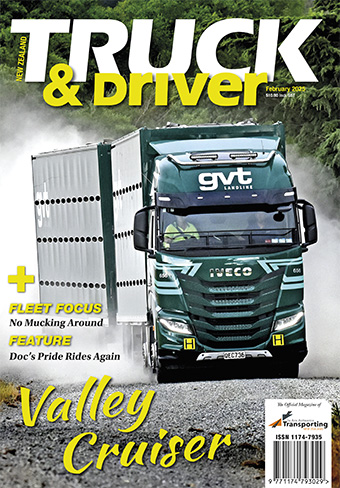Ia Ara Aotearoa Transporting New Zealand News


Taking the cheap option on safety
Over the last couple of months, we have seen the beginning of the new emphasis on road safety.
Unfortunately, investing in newer, safer roads to deal with our growing population and economy is not on the table. Instead, the plan is to slow the country down by reducing speed limits.
Unquestionably, roads and the vehicles that travel on them pose a safety risk. But they also allow for the geographic, economic and social mobility that is fundamental to our society. Sensible transport policy is about finding the balance between these two priorities.
Of course, it's logical that the slower the traffic moves, the less chance of serious accidents – I accept that.
However, there has to be a limit where reducing speeds below a certain point becomes unreasonable and starts having an adverse impact on the overall efficiency of our roading network.
...Over the last couple of months, we have seen the beginning of the new emphasis on road safety.
Unfortunately, investing in newer, safer roads to deal with our growing population and economy is not on the table. Instead, the plan is to slow the country down by reducing speed limits.
Unquestionably, roads and the vehicles that travel on them pose a safety risk. But they also allow for the geographic, economic and social mobility that is fundamental to our society. Sensible transport policy is about finding the balance between these two priorities.
Of course, it's logical that the slower the traffic moves, the less chance of serious accidents – I accept that.
However, there has to be a limit where reducing speeds below a certain point becomes unreasonable and starts having an adverse impact on the overall efficiency of our roading network.
Auckland Transport has recently pushed ahead with a new speed limit bylaw that will reduce speeds across 700 kilometres of the region's roads. Much of the media's focus has been on the new 30km/h inner-city speed limits, but there's also a big group of rural roads that are going to be brought down from 100km/h to 60km/h or even 40km/h.
Motorists can accept a minor reduction in speed limits where that seems reasonable and there exists the quid pro quo that investment is being put into the roads themselves, but asking open-road traffic to crawl along at 40km/h seems on the surface of it to be pretty drastic.
The Government is also pushing piecemeal proposals to lower speed limits on main highways around the rest of the country, with no consideration of the impact on freight movements.
In the South Island, local residents and the New Zealand Transport Agency are at loggerheads over lower speed limits to reduce accident numbers on State Highway 6, from Nelson to Blenheim. If approved, the limit for the entire journey between the two towns, about 110kms, would not be more than 80km/h at any point.
NZTA says the "technical assessment of the state of the road" was the reason behind the proposed reduced speed limit.
I would argue that if the roads are not "technically" safe, the Government should be spending money on upgrading them, not simply reducing the speed limit to suit what they know is a deteriorating piece of infrastructure.
The impact on road freight of such speed limit changes can be significant: In the Blenheim-Nelson area, it's estimated that the new speed limit will extend truck travelling time by 20 minutes each way.
That means that, where drivers can now do three round-trips a day, they will have to reduce that to two, to stay within legal limits. This will result in an increase in costs that have to be passed on down through the supply chain and will eventually hit consumers and exporters.
Delegates at September's RTF Conference were assured by the Minister of Transport that 160 deaths and serious injuries will be prevented each year through the Government's "targeted safety upgrades" to our roading network.
Unfortunately, two years into this Government's time in office we haven't seen much evidence of these safety upgrades. All we have to show for it is the scrapping of a plethora of much-needed new motorways and a whole lot of money siphoned away from roads to pay for pet projects such as the Wairoa to Gisborne rail line and the complete shambles that is Auckland's light rail.
To be fair, it is not just this Government to blame – there has been a chronic under-investment in roading for 20-30 years. The last Government focused on building new motorways through its Roads of National Significance Programme, but undeniably failed in the adequate maintenance of existing roads. This Government, according to Twyford, is all about reversing that.
But the reality is we need it all. We need general improvements in maintenance and upgrades across the whole network. We also need the East-West Link, a new motorway between Katikati and Tauranga, four lanes from Levin to Wellington, and an upgrade of State Highway 1 from Christchurch to Ashburton. We need the Manawatu Gorge replacement with four lanes...and we need the Mount Messenger Bypass.
As much as this Government doesn't like to acknowledge it, big new motorway projects are critical to deal with increasing traffic volumes, increasing economic activity and to help future-proof our transport network for decades to come.
The fact is that the longer we tread water on our roads, the further we get behind. The recently-released National Freight Demand Study shows that since 2012 there has been a 18% increase in the overall freight task to nearly 280 million tonnes per year – 93% of which is transported on the road.
Despite the best efforts of politicians and bureaucrats, people and businesses choose the transport mode that best suit their requirements, and in the 21st Century, where timeliness and flexibility is everything, the best choice will continue to be the road.
This Government has a massive surplus and some of the cheapest borrowing conditions in history. The best investment it could possibly make with that is to our roads.
Blanket speed limit reductions are merely a sticking plaster over what is a self-inflicted wound. The only sure cure for our roading network is new roads, better roads – roads that are not just safe, but also fast, and will help power our economy through the 21st Century.




 + EQUIPMENT GUIDE - FREE
+ EQUIPMENT GUIDE - FREE
